Text and photos copyright © 2018 Steve D’Antonio Marine Consulting, Inc.
From the Masthead
It’s happened on countless occasions, most recently just a few weeks ago while on a sea trial out of a South Florida inlet. The conditions were bumpy, 6 foot seas with a short period, (along with the most vivid case of sea smoke I’ve ever encountered in southern latitudes, the air temperature was in the low 40s, see photo). Ideal as far as sea trials go. The pilothouse was a busy place; the buyer, helmsman, mate, brokers, surveyors, mechanics etc. were all coming and going. The helmsman was concentrating on safely piloting the vessel when it happened, an alarm began to sound, a moderately low level rhythmic beep, beep, beep. Pilothouse alarms are common on large, complex vessels of this sort, and so initially no one was particularly concerned. However, the longer it went on the more folks began to notice. Predictably someone eventually said, “What’s that for”. The response was silence, no one knew. Eventually the source was identified, and it was not critical, however, how is one to know?
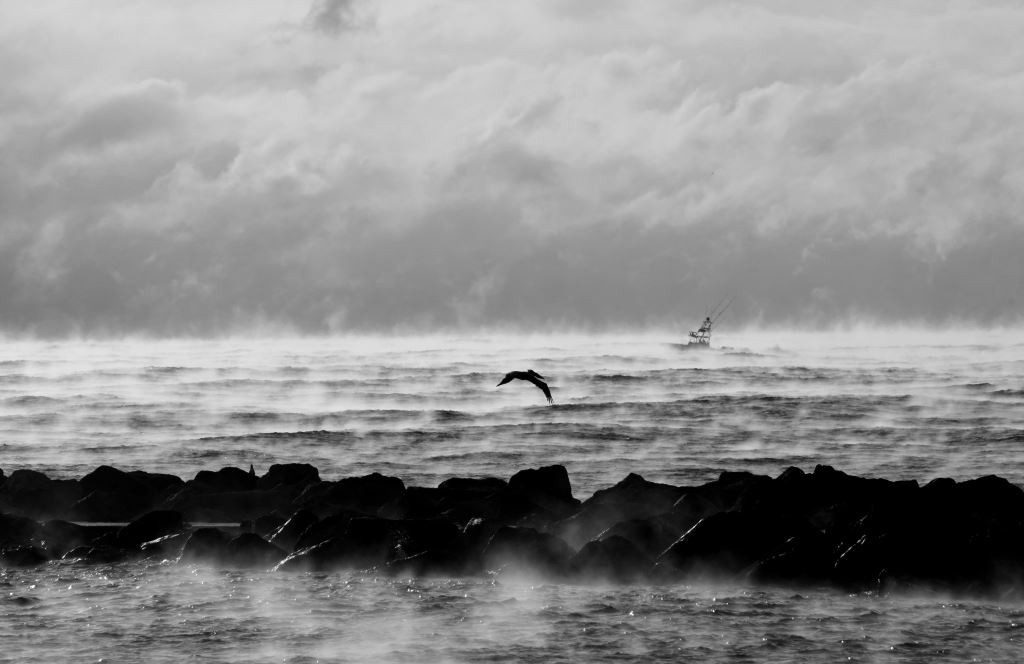
A few years ago, while making an early spring passage from the UK to Germany aboard a new vessel, through conditions that were positively horrendous, the windshield looked like the proverbial washing machine, a similar event occurred. I was on watch alone, the other two crew members had gone off duty thirty minutes prior and were getting some much-needed rest. As I sat in the helm seat hanging on to its arms, contemplating the next wave impact, an alarm sounded. This time, however it was different, the vessel’s central monitoring system flashed a large red bar across the bottom of the screen which said, “FIRE”. Indeed, this was a genuinely serious issue and there was no mistaking it. As it turned out, a dashboard monitor had overheated and began to emit smoke behind the helm station, where, thankfully, a smoke detector had been installed. As it turned out the problem was not serious, and shutting down the monitor resolved the problem for the moment.
I’ve been asked by boat owners and buyers on countless occasions, if there is a means by which disparate pilothouse instruments could be interfaced, strictly to create a central alarm panel. It would simply consist of a panel with the names of various components, AUTOPILOT; STABILIZERS; DEPTH; ENGINE etc, each with its own pilot light. When an alarm sounded, the light adjacent to the device name would illuminate. It sounds like a simple concept, and yet to the best of my knowledge none exists. While many components can be interfaced via an NMEA 2000 or N2K network, not every component has this option and even when it does, getting a simple alarm indication on a central display can be challenging. It seems the best option involves the use of a vessel-wide monitoring system such as a Maretron or BÖNING, however, while I like these systems they are costly and complex and not easily added to an existing vessel, and they are probably overkill for the goal of obtaining nothing more than a central alarm system.
Thus, I’m throwing down the gauntlet, if a marine electronics manufacturer, or creative technician can come up with such a system, analogue or digital, and relatively easy to install, I suspect he or she would have no shortage of interested parties.
This month’s eMagazine feature article covers the subject of coaxial cable performance and selection. I hope you find it both interesting and useful.
The Low Down on Coaxial Cables and Connectors
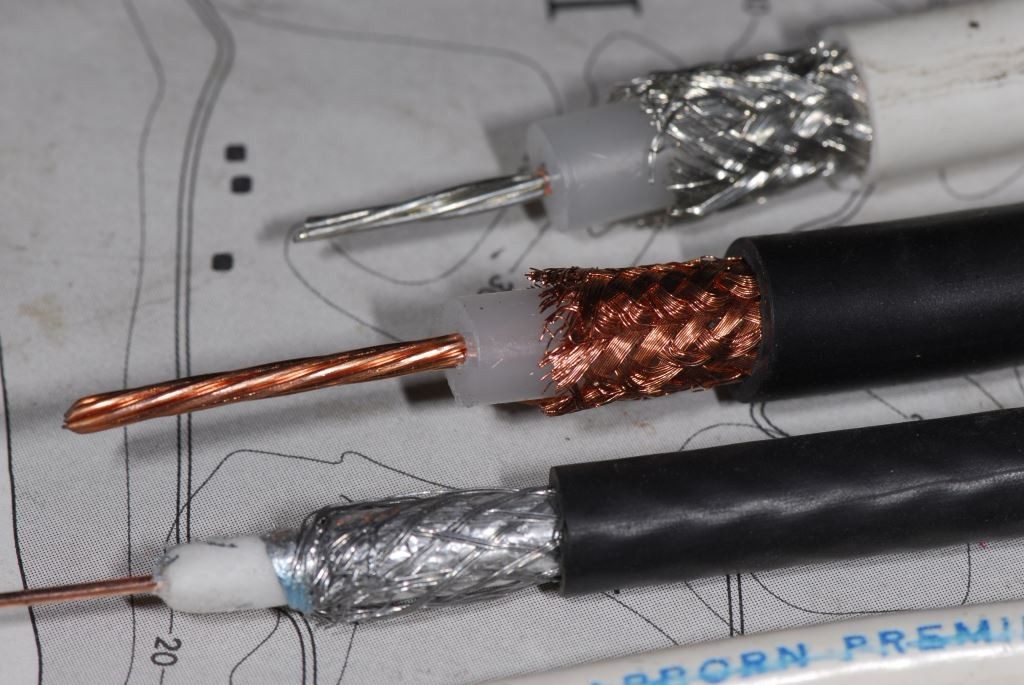
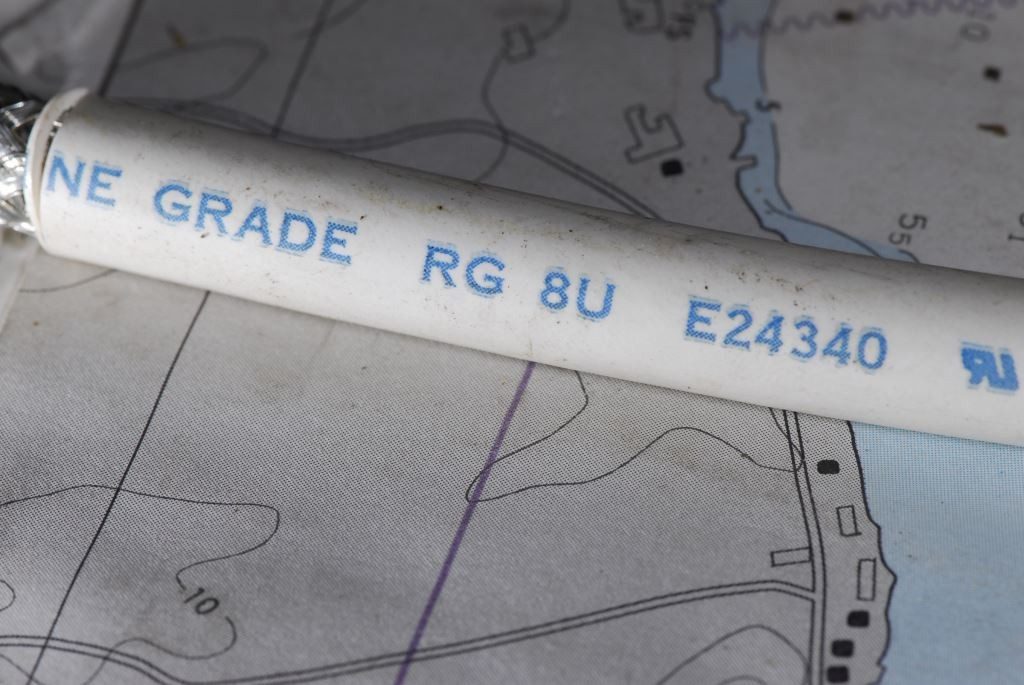
Coaxial cable is available in a range of sizes, types, and performance characteristics. Cost is usually a good indicator of performance and quality.
The axiom out of sight out of mind applies as much aboard boats as anywhere else and in my experience it is especially applicable to marine electrical and electronic systems. Because flaws, faults and defects are not readily apparent in these systems, they tend to go unaddressed. The issues are, however, often quite noticeable when one knows how and where to look.
Coaxial Cable 101
Take for instance the manner in which a radio transceiver ( a transceiver is simply a combined receiver and transmitter) or receiver such as a VHF, SSB, AIS, shortwave, GPS, cell phone, cellular or Wi-Fi booster is wired to its respective antenna. With the exception of some Wi-Fi boosters, which use a data cable, in all of these cases the cable used for this application is known as coaxial, which is a reference to the inner and outer conductors sharing the same axis. The inner core, it’s typically a series of coarse strands but may also be a single conductor, carries the signal while an outer tube-like grounded conductor, usually a braid or foil or combination of the two (the greater the coverage of the shield the better, it’s often expressed as a percent that’s typically between 65% and 95%), reduces loss or degradation of the signal while minimizing electromagnetic interference from other radio signals or electrical equipment. Many homes in the US, Canada, Europe and elsewhere in the developed world have coaxial cable for television and in many cases internet applications, connecting external antennas, satellite dishes, cable TV, and internet service providers to television sets and routers in homes and offices.

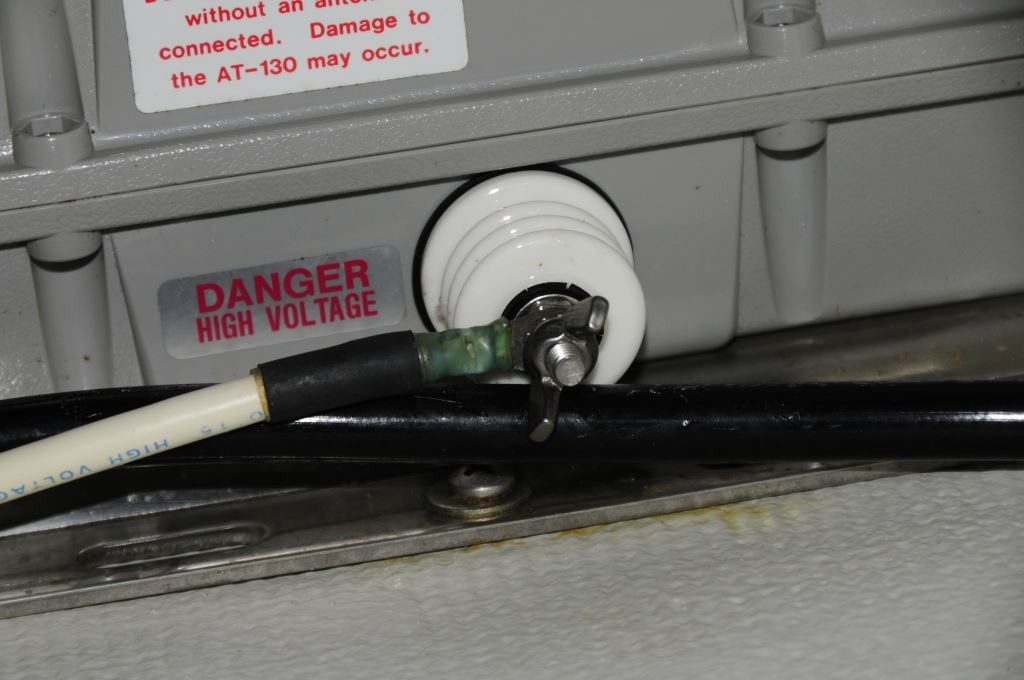
The connection between an SSB tuner and the antenna relies on GTO cable, which is vastly different than coaxial cable. It acts as part of the antenna, and the terminal on the tuner, shown here, should be insulated.
If an ordinary wire is used rather than a coaxial cable for the transmission of radio frequency, or “RF”, energy it will simply act like an antenna, transmitting signals inside the vessel (which often leads to interference with and malfunctioning of other equipment), losing those signals as they are received and sent to and from the radio and antenna. The shield is grounded at the transceiver end and thereby keeps the signal contained within the cable and prevents the introduction of unwanted signals into the center core conductor. The spacing between the shield and the center core is critical and must be kept constant. Kinking, crushing or sharply bending (most coaxial manufacturers specify a minimum bend radius) a coaxial cable compromises this critical spacing, which will degrade the signal. Removing the dielectric insulator, the material found between the shield and the center core and terminating or splicing the core and shield “manually”, like ordinary wires, also leads to signal loss and increases the likelihood of interference both to and from the cable.
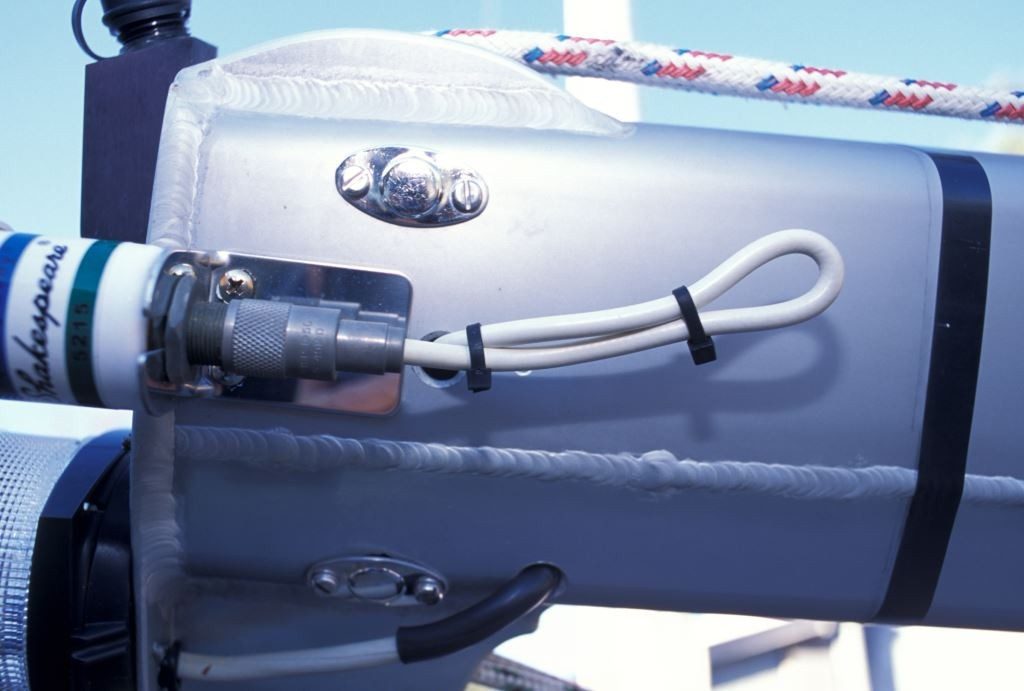
Sharp bends stress coaxial cable and can affect performance, they should be avoided.
Additionally, any abrupt change to the dimensions or spacing of the core and shield causes a reflection of the radio waves back to the source, to the transmitter. This phenomenon, known as standing wave, creates a bottle neck, through which signals have difficulty passing, ultimately degrading the transmission quality. Standing wave is measured as a ratio, known as standing wave ratio or SWR. In short, it’s a measure of the difference between the maximum RF and the minimum RF voltage along the cable. What’s most important about this ratio is ensuring that it’s kept low. If there are no reflecting sources, if the cable is uniform and properly terminated, then the SWR would, ideally, be 1:1.
Another factor that affects SWR is the matching of the impedance or resistance of the cable, this is a function of the cable’s dimensions and construction, to the impedance of the devices to which it’s connected; the transceiver or receiver and the antenna. When the two are matched, they appear “transparent” to the RF signal and reflections and thus SWR are minimized. Most coaxial cables used for radio transmission and reception aboard have an impedance of 50 ohms, while some, such as those used for television, are 75 ohms. It’s important that the correct impedance cable be used and that it match the antenna and transceiver/receiver in order to ensure a low SWR.
Cable Selection
A variety of coaxial cables are available, in a host of sizes, with a range of loss characteristics, and impedances as well as a range of quality and associated expense from many different manufacturers. Selection can be truly confusing even for professionals.
Proper cable selection depends primarily on a few details. Chief among these are the recommendations of the equipment manufacturer. In many cases, the maker of a radio will very clearly spell out the type of cable that should, depending upon the installation conditions, be used. In the absence of that information, however, additional criteria must be relied upon. Begin with determining the frequency range of the equipment. This isn’t as difficult as it sounds. In general terms, the most commonly used radio equipment falls in to a few well-defined frequency ranges, the most common and those relying on conventional coaxial cable are HF, SSB or shortwave, which operates between 3 and 30 MHz (an abbreviation for mega Hertz, or million Hertz, named after German physicist Heinrich Hertz who made significant contributions in the study of electromagnetism, it’s a measure of the number oscillations that occur per second which defines the radio frequency, in the past it was often referred to by the designation it replaced, cycles). Marine VHF radio (and AIS) frequency is between 156 MHz and 158 MHZ and cellular frequencies are between about 850 MHz and 1900 MHz GPS satellites, and receivers operate at about 1500 MHz Wi-Fi tops the list at between 2.5 and 5 GHz or giga-Hertz, which is the abbreviation for a billion Hertz.
The reason the frequency is important where cable selection is concerned is the attendant inefficiency or loss; the higher the frequency the greater the potential for loss from the cable. Thus, several protocols can be derived from this truism. Gear that operates at higher frequency must use higher efficiency, lower loss cable (and connectors, more on those below) and the runs between the receiver/transceiver should be kept as short as possible, necessitating even lower loss cable. Of course this is true of all radio equipment, low loss cable and short runs are always desirable, however, it becomes more critical for VHF, AIS and cellular/Wi-Fi gear. Although the loss characteristics are not as great where SSB/HF/shortwave are concerned, these installations still can and regularly do suffer from poor cable selection and unnecessarily long runs or a combination of the two.
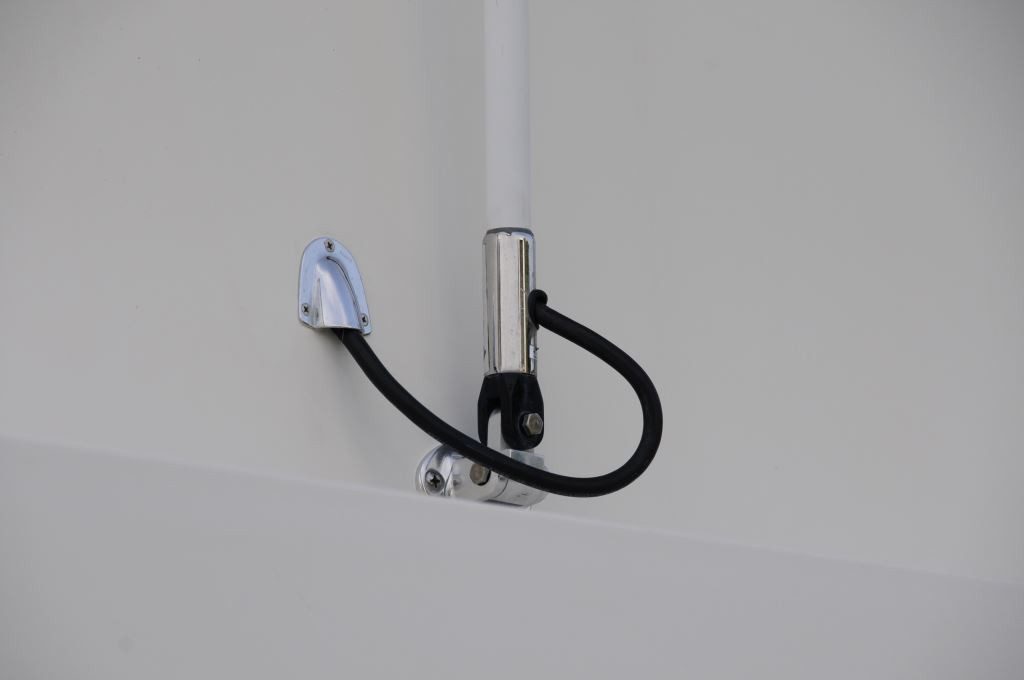
Heavy, extra low loss cable, like that shown here, is well-suited for longer runs and higher frequencies. It’s bulky but worth the effort.
As in illustration of how coaxial cable loss may affect transmission characteristics I’ll share a scenario I frequently encounter aboard vessels I inspect. A VHF radio is installed in the pilot house aboard a 52-footer. The cable run from the radio to the antenna, which is mounted on an arch or mast above the fly bridge, is 40 feet, assuming the installer hasn’t left an additional 20 feet of cable coiled up beneath the helm, which is highly undesirable and not uncommon. The cable “run” is a measure of actual linear feet rather than an imaginary straight line drawn between the antenna and transceiver. The output of the VHF radio is 25 watts (or 1 watt on specified channels) and the cable that’s been chosen, for this example, is a common type referred to as RG 58U, is about 3/16 inch (4.7mm) in diameter, pretty gossamer. The actual power output at the antenna-end of the cable is just 13.4 watts, or a reduction of 45%, the rest of the power has been “lost” in the cable run. It’s important to remember, the type and location of the antenna has a considerable effect on the efficiency of the transmitted signal, however, in plain terms, the lower the cable’s loss, the better and the more power the antenna receives the greater its transmission (and reception) characteristics.
If, on the other hand, a more efficient cable is chosen, say RG-8X, a common, ¼ inch (6.3mm) diameter, higher efficiency lower loss cable, which is often used for VHF installations, with all other factors remaining the same, the wattage reaching the antenna increases to 16.9 or a reduction of 32%. If a still lower loss cable is used, the Cadillac of coaxial cables and my personal preference, Times Microwave LMR 400, can be utilized, this cable is a hefty 0.405 inch (10.29mm) in diameter, the reduction in radio energy reaching the antenna is a scant 12%. Now, imagine the same circumstances placed on a cellular coaxial and antenna installation. Recall that cell frequencies are many times higher (with loss many times greater) than those of VHF and their output power many times lower, and it’s easy to see how the performance can be significantly degraded.
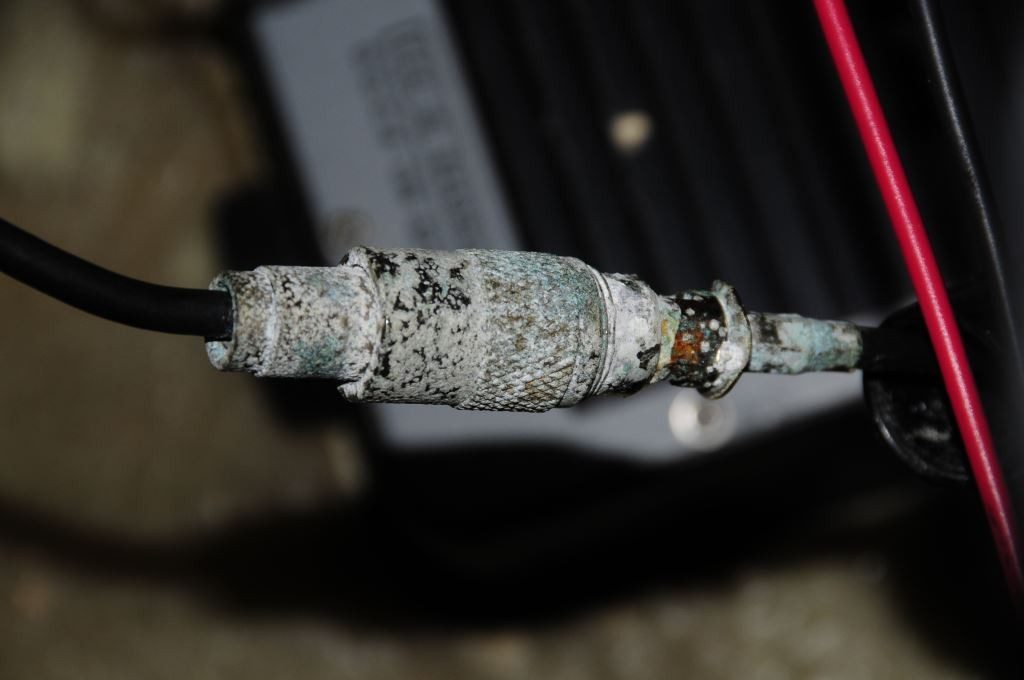
Exposed coaxial terminals will corrode. In wet locations, including bilges, they should be installed using a light film of dielectric grease, and then covered with heat shrink tubing or high quality electrical tape; if on weather decks these must be UV resistant.
As you can see, the price that is paid for low loss; essentially cable bulkiness (and commensurate expense) is very clear. The same calculations can be carried out for other cables and transmission frequencies with some very startling results. The high frequency of cell phones, for instance, coupled with their low output power of between a quarter and three watts (the latter for boosters) makes for very special coaxial cable requirements. In this case low loss cable should always be used even for relatively short runs. The same holds true for Wi-Fi applications and, once again, every effort should be made to keep these cable runs as short as possible.
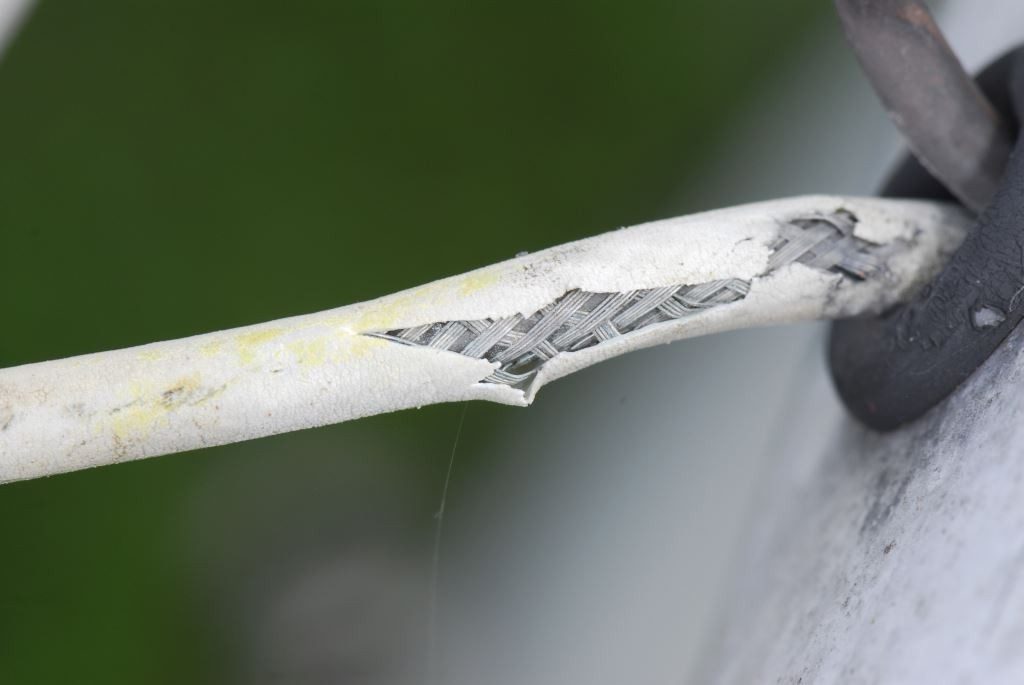
Once a cable’s shield is exposed, and it has been exposed to the elements, it is almost certainly compromised.
By the same token, even though SSB frequencies are lower and thus less loss prone, the often long run between the transceiver and the antenna and/or tuner means these installations call for low loss cable. Additionally, in spite of the fact that their output power is considerably higher, up to 150 watts, the range over which they transmit is significant, hundreds or thousands of miles and as such it’s worth the effort and expense of ensuring the antenna receives as many watts of transmission power as possible. Thus, using RG8X for a 50-foot run between a helm-mounted transceiver and the lazarette mounted tuner would result in an 18% power loss, assuming other common loss or SWR matching inefficiency factors. This may not seem like a significant number, however, once again, when the transmission distance is considered it may mean the difference between a voice communication that’s intelligibly received and one that’s simply ignored because it’s garbled, faint or static-laden. If the Times Microwave LMR 400 cable is used the loss becomes just 7%. Every watt counts when it comes to marine communications so don’t let an installer tell you it’s “fine” or “there’s no real difference”, insist on low loss cable. Another note on SSBs, most utilize a separate antenna tuner that is or should be located close to the antenna, it’s connected to the transceiver using coaxial cable while the connection between the tuner and the antenna utilizes another specialized, non-shielded cable referred to as GTO-15. Although it resembles GTO cable, coaxial cable should not be confused with or used in its place, GTO is actually a transmitting part of the antenna, and thus is thus it should not be run inside accommodation spaces.
When choosing coaxial cable, in addition to the criteria mentioned above, ensure that it’s suitable for marine applications. Fortunately, this isn’t simply a way for manufacturers and retailers to charge more for a product that’s no different than other land-based versions. Most marine-grade cable utilizes corrosion resistant tinned conductors. The cable’s jacket may be white or black, although proprietary marine coaxial tends to be white. The name of the manufacturer as well as the cable type, RG 8X or LMR 400 for instance should be clearly printed on the jacket. Having said that, the lowest-loss cable may not be marine rated; in my opinion low loss trumps corrosion resistance.
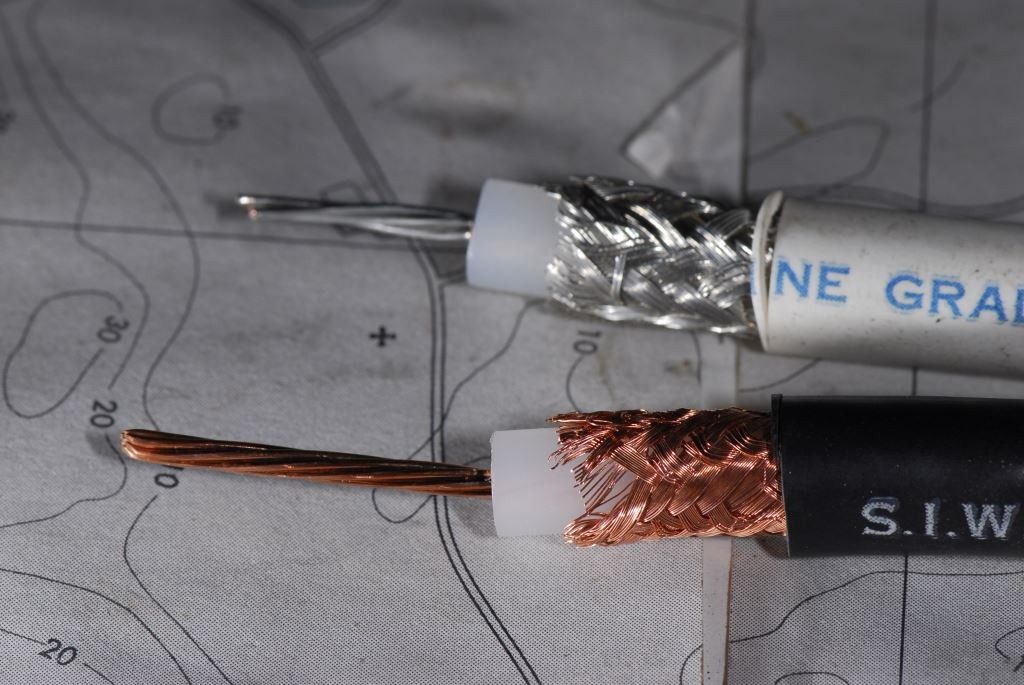
While tinned, corrosion resistant conductors are desirable, some very low loss cable is not available in this format. Given the choice, choose low loss over corrosion resistance. Careful attention should be paid to waterproofing installations regardless of the type of cable that is used.
Connectors
The other half of the coaxial cable equation involves the type and method of attachment of connectors. Coaxial cables require special terminals that must be installed following clearly defined techniques, the transgression of which nearly always results in diminished performance, or worse, no performance at all.
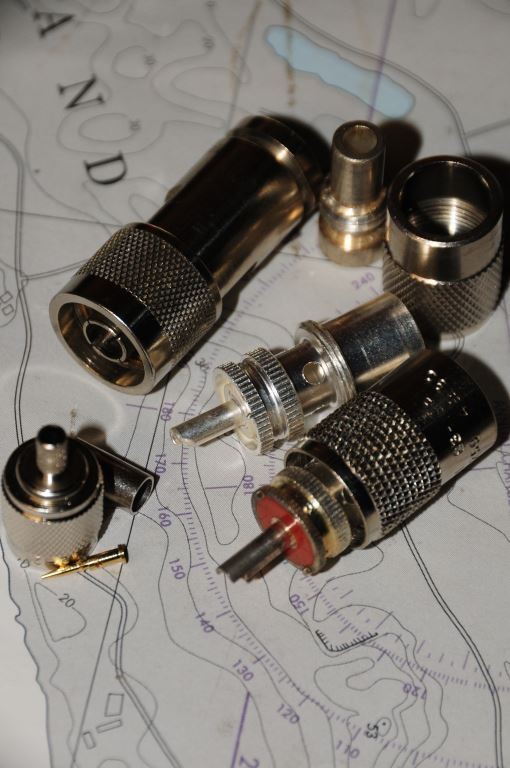
A selection of coaxial terminals, each specifically designed for a particular cable type.
The volume of connectors available is nearly endless and quality of materials and construction covers a broad spectrum, from economy to gold plated, literally. Connectors should be purchased from name-brand respected manufacturers (often, higher quality connectors are embossed with the manufacturer’s name) such as Amphenol, they invented modern coaxial connectors, Ancor, Shakespeare, Times Microwave and others. High quality coaxial connectors are made of brass or beryllium copper with silver and/or tin plating and in some cases gold plating (the conductivity of silver is higher than gold and even higher than copper; however, gold does not tarnish, although silver’s silver oxide “tarnish” is conductive). The insulating material between the center core and the outer shield should be capable of withstanding substantial heat for connectors that are designed to be soldered, at least 300°F. Lower quality, and low cost, connectors often utilize a form of plastic whose melting temperature is well below this threshold, which makes a solid solder joint difficult to achieve without damaging this insulator material. Check these connector specifications before purchasing or specifying for others.
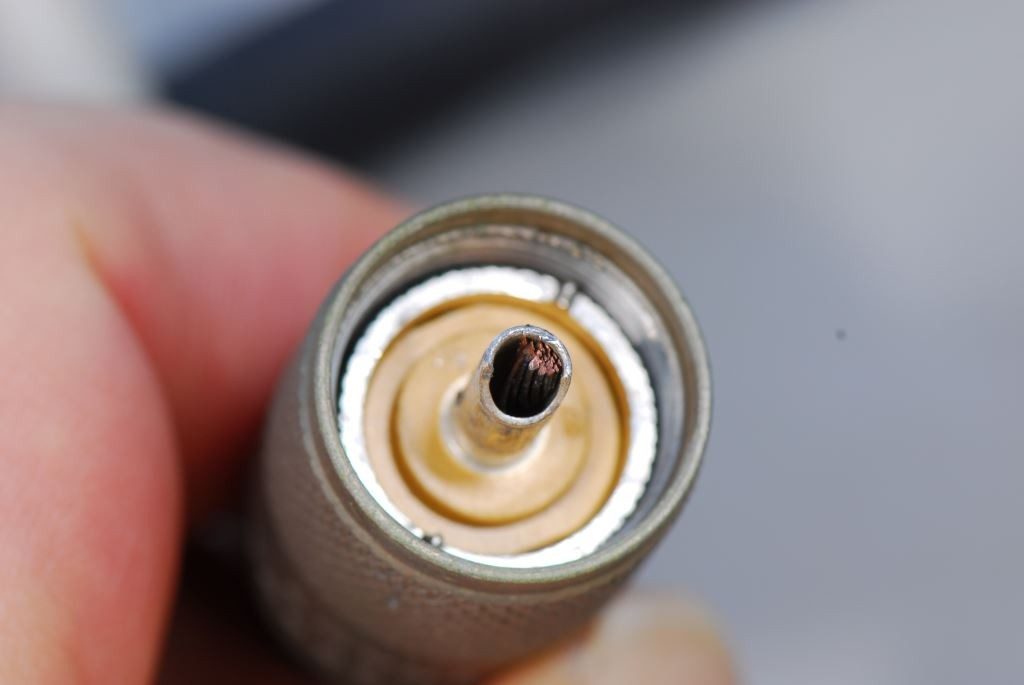
Failing to use solder on coaxial terminals that are designed to be soldered virtually guarantees poor performance.
Much like coaxial cable, connectors are available in many styles and varieties. The key difference between them is the frequencies for which they are rated. The most common connector, known as the UHF style, has been around for many years, having been invented by an Amphenol engineer in the 1930s. Because its impedance is variable it’s only suitable for frequencies up to about 300 MHz, which includes HF/SSB/Shortwave and VHF. The most popular designations for UHF connectors are PL-259, the male, and SO-239, the female portion that’s typically located on the equipment and in some cases the antenna. Anything above 300 MHz, cell, GPS, Wi-Fi etc, requires a more sophisticated type of connector. These lower loss units include N-Type, BNC, TNC and Mini varieties, all of which are typically available for most cable sizes. The primary difference between the UHF and these other connectors is those suitable for frequencies above 300 MHz maintain constant impedance, which, at these frequencies, keeps SWR and RF transmission efficiency at an acceptable level.
Termination
At one time the only way to professionally install a coaxial connector for anything other than TV applications was by using solder. It remains an excellent approach; however, many quality connector manufacturers now offer reliable solder-less coaxial connectors. In some cases special crimping tools or dies are required while in other cases all that’s required is a needle nose plier.
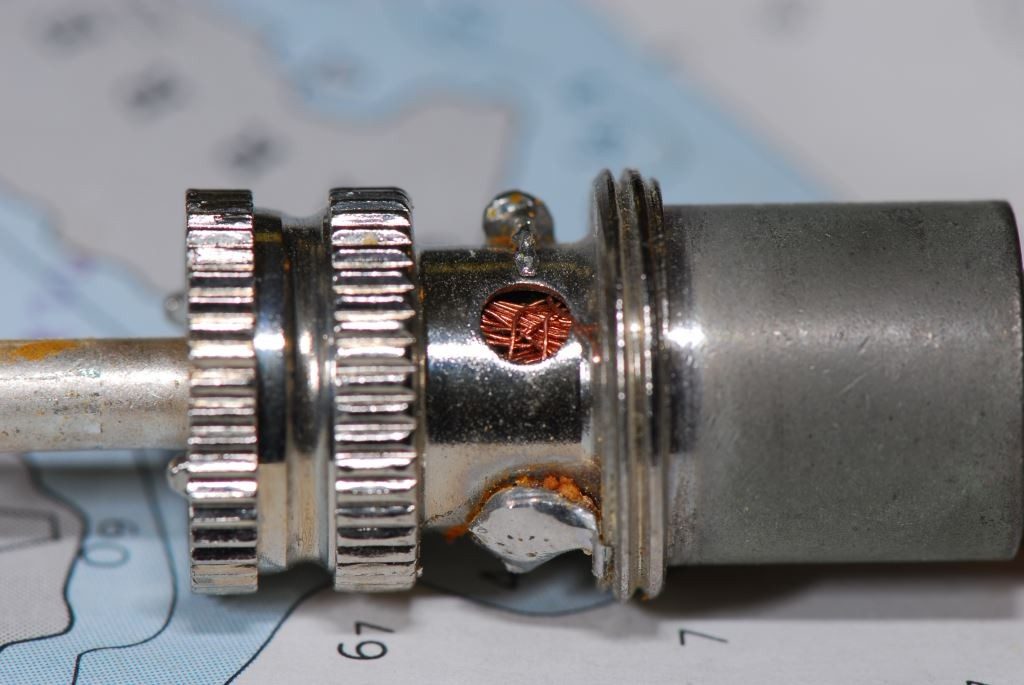
Properly soldering coaxial terminals requires practice. These “cold” solder joints are unacceptable, and all holes should be filled.
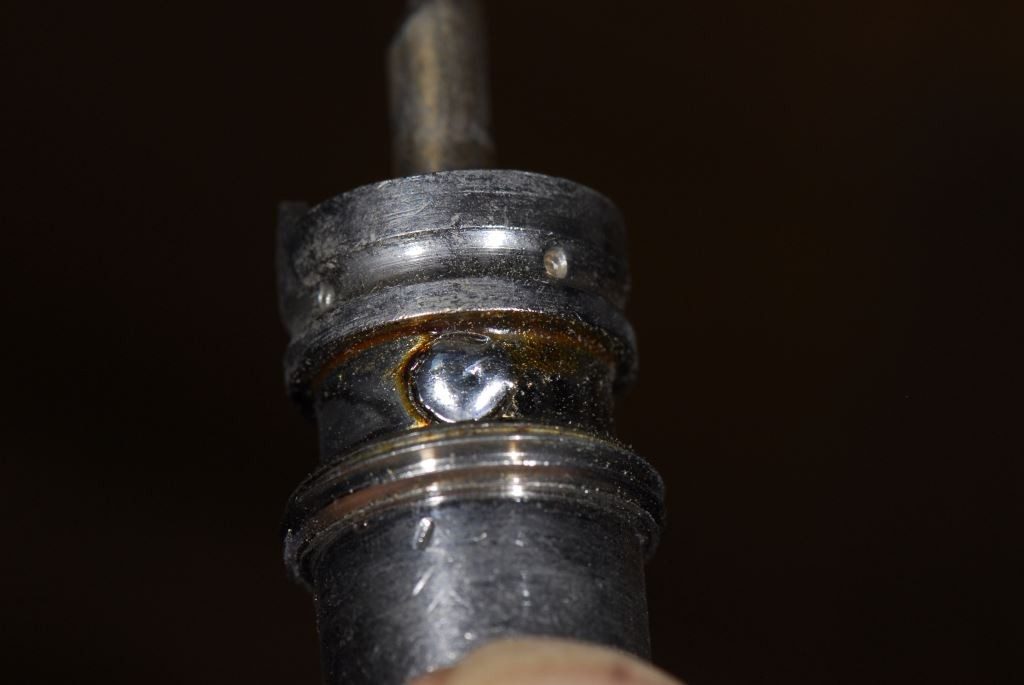
Proper solder joints, like the one shown here, are critically important. These can be difficult to achieve if inadequate heat is available when, for instance, the termination is being made outdoors, in breezy conditions.
Whichever approach you use, be certain you understand how the termination is to be made. A single hair-like strand of a cable’s shield that’s out of place can create a short, which in turn will cause the associated equipment to malfunction. Most coaxial connector manufacturers include or offer detailed instructions for installation of their products, take the necessary time to familiarize yourself with the procedure, although not terribly difficult it’s often a specific multi-step process.

Great care must be taken when installing coaxial terminals. A single errant shield strand, making contact with the center conductor, will cause a short and diminish performance.
When coaxial cables are initially terminated they should be checked for both continuity as well as short circuits. After installing connectors at each end and before connecting the cable to the antenna and transceiver or receiver, test for continuity between the shield and the core conductor using an ohm meter.
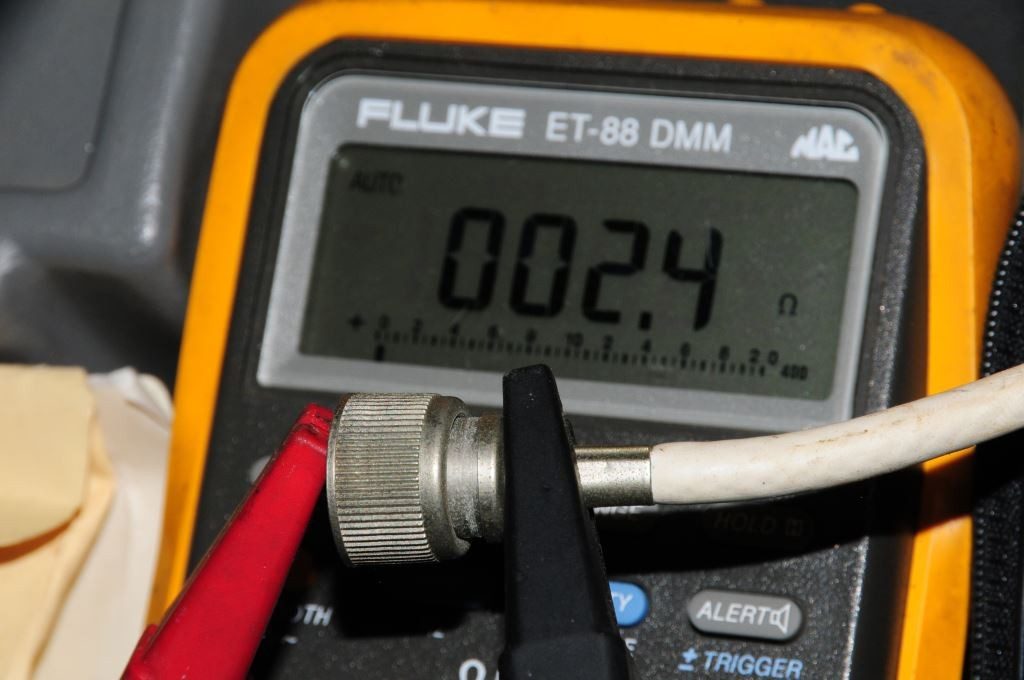
Testing cables using an ohm meter, after terminals are installed, can identify shorts and open circuits before the installation is complete.
The resistance should be infinite, i.e. no connection what so ever between the two. Any connection, regardless of how high the resistance, is too much, it’s a short circuit that will degrade performance or prevent the gear from operating all together. Then, using a jumper wire, connect the shield and the core at one end of the cable (make the connection between the center pin and outer body of the connector) and measure the resistance of the connection at the cable’s opposite end. This will confirm that the connectors are properly installed and are making good, low resistance bonds with the cable. In this case the reading should be exceptionally low, no more than one or two ohms, most of which is a result of resistance induced by the terminal to cable interface. High quality coaxial cable alone, without connectors, possesses roughly 1.5 ohms of resistance per 1000 feet.
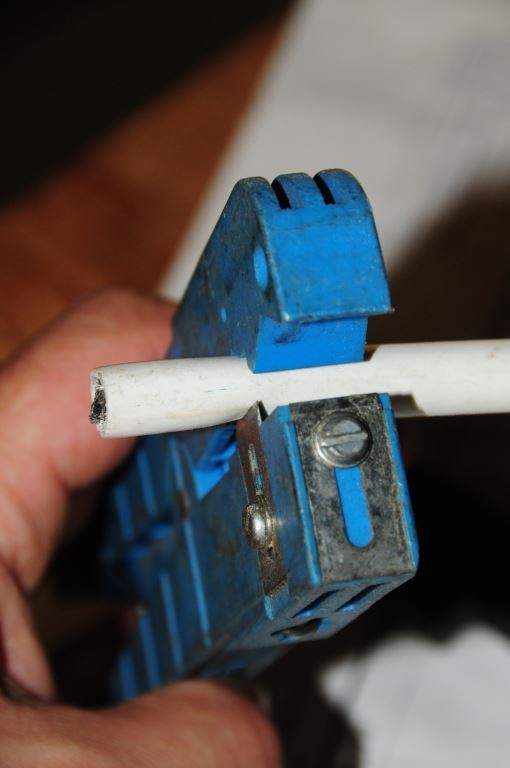
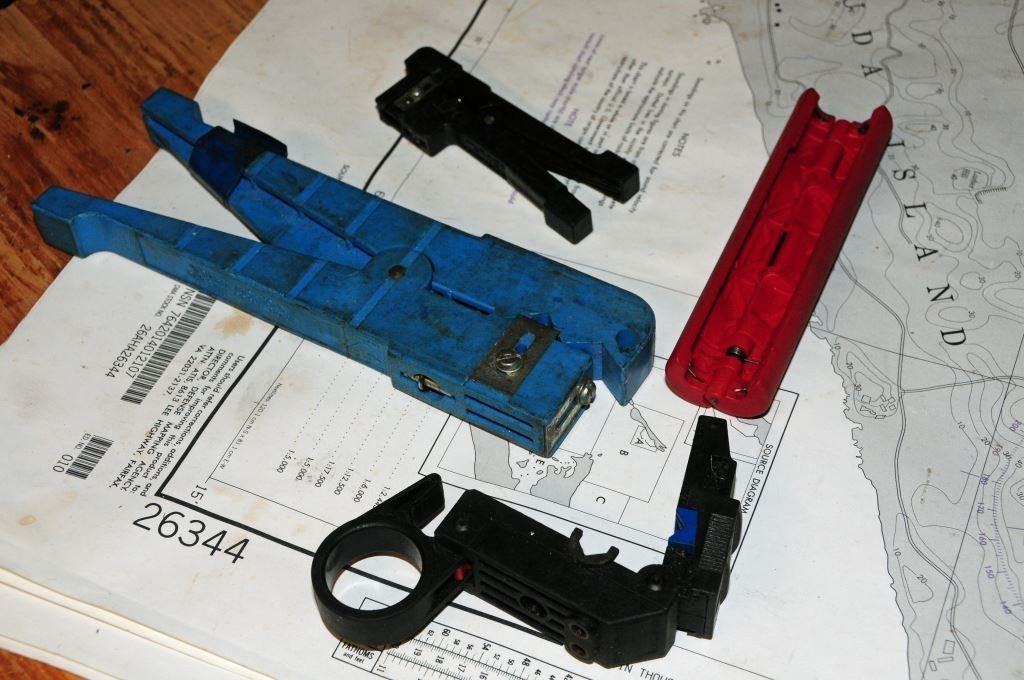
While it can be done manually, those preparing coaxial cable for terminal installation should utilize readily available special tools.
Few coaxial connectors are designed to be water proof or even water resistant. Therefore, installations on weather decks should take this into account and appropriate measures taken to prevent water entry into cables. Because the shield used on most coaxial cables is made up of a very fine wire braid, it tends to absorb water via capillary action, even when it’s not directly exposed to free water, heavy fog or chronic high humidity will induce water entry into coaxial exposed shield. Once that happens, the cable’s performance is almost immediately degraded.
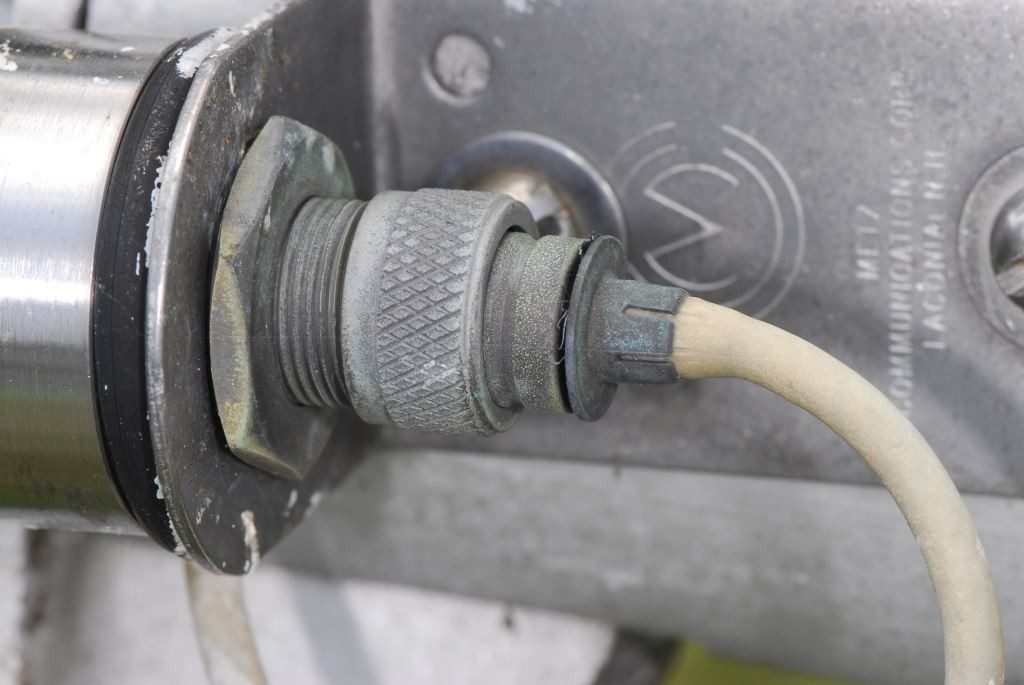
A poorly made connection, it lacks water proofing. Note the visible shield strands, these will act as wicks for water entry into the cable.
Coaxial terminations made on weather decks should be afforded the benefit of dielectric grease applied to the core pin and threaded or bayonet connection before assembly and then sheathing in heat shrink tubing or weather-proof electrical tape (before applying remove all traces of dielectric grease from the outside of the connector and, if using tape, be sure to start the tape wrap low and work upward to the attaching end of the connector, to create a water shedding shingle-effect in the overlapping wraps). Additionally, if possible, include a drip loop so the cable does not act like a flume, channeling a stream of water toward the connection.
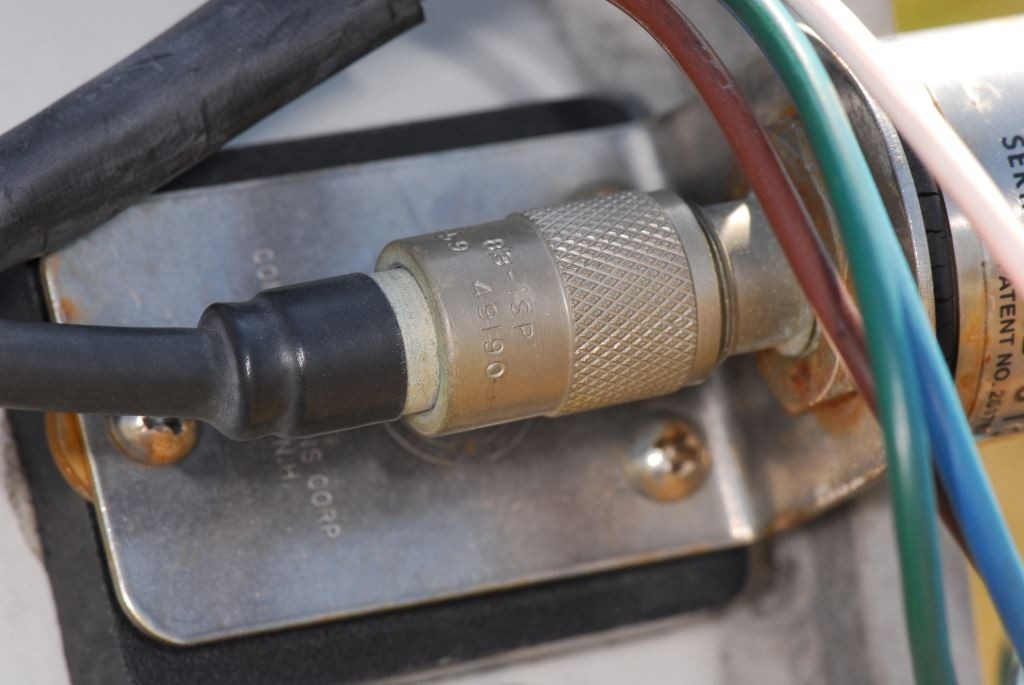
Ideally, this terminal should be completely enclosed in heat shrink tubing.
Because of the importance placed on the type of cable used and because the selection is dependent upon, among other things, the length of the cable run, antennas that are manufactured using en bloc female coaxial terminals rather than pigtail coaxial cables are preferred. When the antenna manufacturer includes the cable as an integral part of the product the user is often stuck with a cable that may not be long enough, requiring a splice. Additionally, if the cable is ever cut, crushed or damaged or if it becomes water logged, the entire antenna may have to be discarded. Additionally, it’s possible that one may wish to utilize a higher quality cable than the one supplied by the antenna manufacturer, especially if a long run is involved. Additionally, antennas that include a permanent pigtail preclude ohm meter testing of cable assemblies. Some antenna manufacturers offer the same style of antennas equipped with either a pigtail or a female coaxial connector. When given the choice, choose the latter so you can use the cable of your choice and so cable assemblies can be tested.
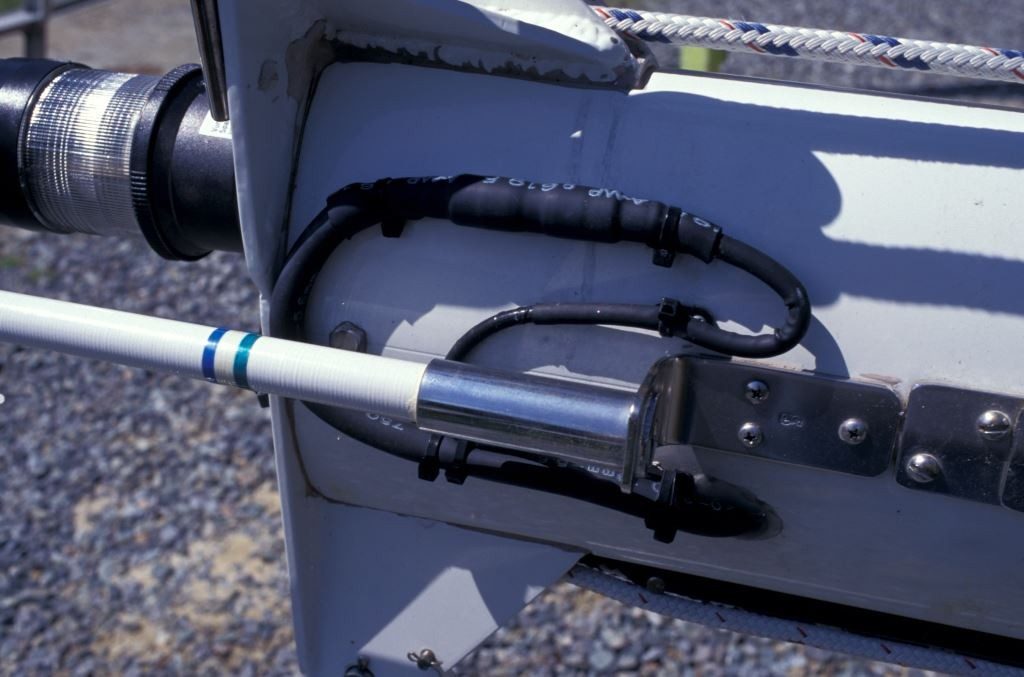
A heavy low loss cable transitions to a smaller diameter “pigtail” cable, one that’s permanently attached to the antenna. While the bend in the smaller cable is too sharp, the heat shrink tube waterproofing is ideal.
Check This Out
Once all of the connections are made the equipment should be tested. That means, for radios, radio checks from the greatest possible distance. Any VHF radio check that’s from a vessel that’s less than 10 miles away is of limited value. The call should not be placed to the Coast Guard, they have more important things to do and their transmitters and antennas are uber-powerful so it’s likely you’d make contact using little more than a wet mooring line as an antenna. I once made contact with a Coast Guard communication facility in Portsmouth, VA while half way to Bermuda, roughly 250 miles off shore. Checking VHF operation by tuning in the weather channel also counts for naught when testing a coaxial and antenna installation.

For VHF installations, the only way to be certain the system is performing properly is to obtain a radio check form a distant station, one that is no less than 10 nm. away.
SSB radio checks should be performed both day and night, with successful nighttime radio checks occurring with stations more than 1000 miles distant. Using an SWR meter on both VHF and SSB installations is an ideal way to check for satisfactory coaxial as well as counterpoise (for SSBs) installation. Cell phone coaxial and antenna checks are somewhat more challenging. You can of course compare the number of available “bars” with and without the external antenna. Clearly, if the external antenna affords you no additional bars, something is wrong. Testing coaxial installations for AIS and GPS transceivers/receivers can be somewhat more challenging, however, at the very least the signal to noise ratio function should be accessed and their operation should be carefully scrutinized and compared to other receivers on nearby vessels when possible. If something doesn’t appear right or if signals are inexplicably marginal or non-existent don’t ignore the problem, find it or seek professional assistance before relying on this gear.
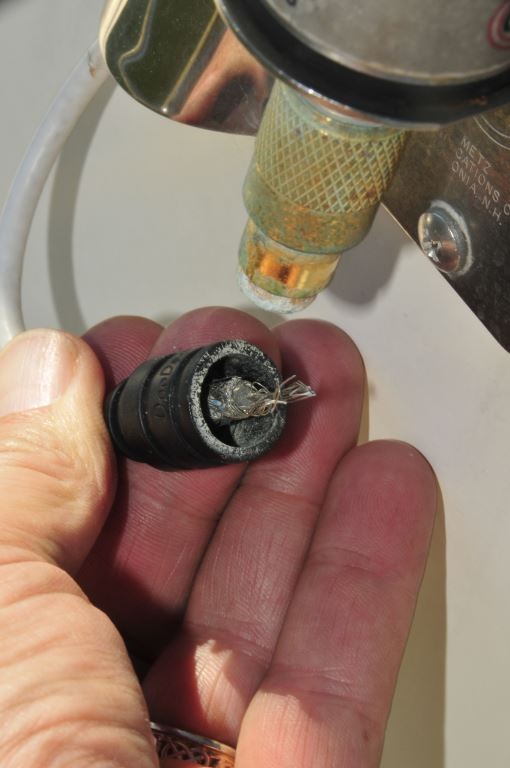
This coaxial cable easily separated from its terminal, likely because it was not properly installed. The boot shown here, while seemingly desirable, can actually retain water. Heat shrink tubing or electrical tape is preferred.
Because the loss is difficult to quantify unless it’s actually measured, or the calculations performed, the user often has no idea of just how bad it is. When I query boat builders or electronics installers about the cable (or antenna) that’s being used in a particular installation, its loss characteristics, length etc. the response is almost invariably, “it’s fine, that’s what we always use” or “no one has ever complained”. In many cases, smaller diameter cable is chosen because it’s less challenging to run. And, “fine” is relative, indeed, the VHF radio, GPS or AIS works with higher loss coaxial cable but how well? After all, if you fail to make contact with your VHF or if an AIS signal from a vessel isn’t received, or if your AIS signal isn’t “seen”, or if you can’t get a GPS lock, will you know it or how often are you thinking that the culprit is the coaxial cable? Now perhaps you will and you’ll know what to do about it.


